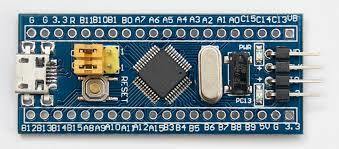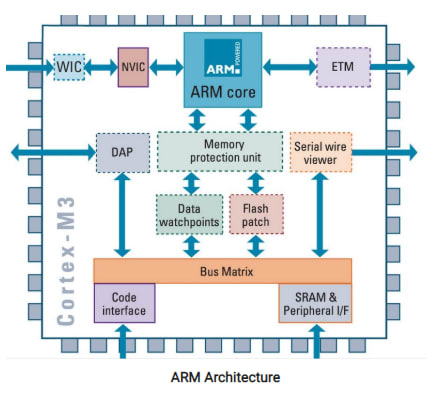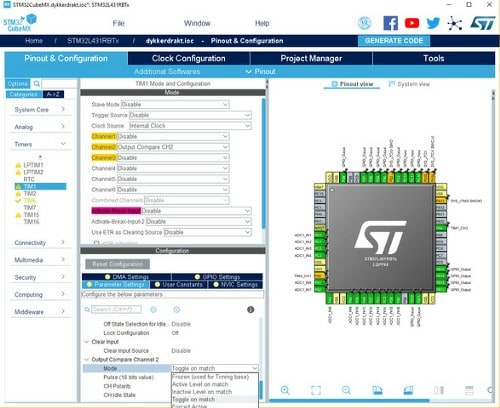The STM32 is a popular microprocessor that could be found in a wide range of products. It also possesses the capability of connecting to various sorts of microprocessors. STMicroelectronics developed the STM32 line of MCUS, which features ARM Cortex-M 32-bit CPU core. Multiple peripheral gadgets like cameras, detectors, motors, and other gadgets could be connected to this microprocessor series and parallel communications networks.

What is the STM32 Microcontroller?
STM32 refers to a series of 32-bit microchips created and sold by STMicroelectronics. STM32 microchips are on the market in a variety of the kinds and variants, and they are part of the ARM-architecture family of Microcontrollers. From basic printers to complicated PCBs in automobiles, microchips are employed in a wide range of tasks. Hence, knowledge of the way to design firmware and integrated systems utilizing STM32 microchips is a compulsory talent for every electrical gadget or communications expert.
STM32 Specifications
These are a few of the STM32's specifications:
- A maximum of 1MB of flash memory is utilized in STM32.
- It makes do with an OTP of 512 characters.
- It employs one-byte static RAM.
- Its working voltage ranges between 1.8 and 3.6 V.
- It employs a crystal oscillator with a frequency range of 4 to 26 MHz.
- It possesses a factory-trimmed RC of sixteen megahertz on the inside.
- The RTC is based on a 32-kilohertz oscillator.
- After calibrating, it possesses an inner RC of 32 kilohertz.
- Sleep stop and standby are two of the modes available.
- The battery powers the RTC, backup registers (20 by 32), and 4KB of static RAM.
- It possesses 42 channels and is made up of three 12-bit 0.5 microsecond analog to digital converters.
- It possesses 12 sixteen-bit timers and 2 thirty-bit timers
- It possesses 136 inputs and outputs at 60Hz frequency.
- It possesses one 38V input and 5V output.
- There are three I2c interfaces.
- It possesses four USARTs, two UARTs, and three SPIs.
Architecture of the ARM Microprocessor
Advanced Risc Machine is the abbreviation for Advanced Risc Machine. It is among the most widely utilized designs in devices like cameras, cellphones, and integrated gadgets. These are well-known for their low power consumption and high performance.

ARM is a 32-bit RISC architecture (Reduced Instruction Set Computing). The address bus of a 32-bit system has 32 lines, allowing it to address up to 232 places. The RISC command denotes that the hardware is complicated and that the hardware handles a significant amount of process management, allowing it to be simpler to program commands for ARM processors.
How to Setup STM32 Microcontrollers in a Simple Way
When setting up the timers and programming the STM32 microchips, you could utilize the STM-CubeMX utilities.

CubeMX is a free tool supplied by STMicrocontrollers for configuring the STM32 microcontroller's initial configuration. It also features a code generator that generates the code needed for network startup on its own. This makes it an ideal tool for programmers who want to concentrate on actual utilization development rather than the time-consuming process of tuning the microchip's timers.
Debugging and Coding
We may use the external devices and GPIO pins straight in the core functions now that the code has been created. The while loop should contain any code that executes in a loop.
We intend to debug, or test and execute the code on the discovery board, immediately you've finished with the operational coding.

Begin a debug process by going to debug (or Ctrl+F5). We have a few choices on the debug box. The final row is the one that we're most worried about. The initial button resets the execution, bringing the program counter back to the start address. The play(run) button is the next button. By pressing it, the program would operate until it reaches the end of the code, or it would begin an infinite while loop.
Keil, on the other hand, gives facilities for reviewing code execution one line at a time. The code is navigated using the bracketed arrows. The first one lets you enter a function or execute a line of code. The second lets you proceed to the following line. It would continue to run one line at a time, but it would not enter a code. The third option enables you to exit the operation.
These resources show you the line of code that is currently being executed and what the sign up numbers are at the completion of that line's implementation. This could come in handy if you're trying to figure out why a function isn't working or if you're trying to hunt out inadvertent infinite loops.
Pinout for STM32
The key pinouts of the STM32 are:

CN6
It is a power adapter pinout, and 3.3V is given at this connector.Pin Reset
The microchip is reset with it.+3.3V pin
3.3V is extracted as an output from this connector and utilized in powering the microchip.+5V pin
It's a pinout for a 5V output.GND pin
This is a ground pin.CN5
It's a collection of electronic pinouts D8 to D15, which are utilized for SPI.D13, D12, D11, and D10 Pinouts
For SPI transmission, these pinouts serve as a serial clock, master in slave out, master out slave in, and SC pinout.CN9
These are digital pinouts, and they range from D0 to D7.D0 and D1
For USART communication, these two pinouts serve as receiver and transmitter.PD2
It's the GPIOs for port D.PB7, PB8, and PB9
They are the pinouts for port B.PH0 and PH1
They are the pinouts for port H.
STM32 Applications
Here are a few examples of STM32 tasks:
- It is utilized in compact electrical gadgets that utilize lower electricity.
- Robotics and several electrical tasks also utilize this microchip.
- It is also employed in the automation of systems.
Conclusion
The goal of this article was to give an overview of the STM32 platform including its specifications, pinouts, and utilizations. It does not delve into the specifics of making a project or writing code. Hopefully, this has given you a fair understanding of the STM32.



Top comments (0)